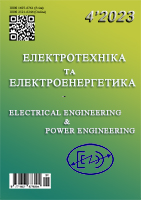To the question of construction of welding inverter sources with a high power factor
DOI:
https://doi.org/10.15588/1607-6761-2023-4-3Keywords:
power factor, welding, welding inverter, power supply, arc ignition, arc burning stabilization, open circuit voltageAbstract
Purpose. Design a power-factor-corrected, energy- and cost-efficient switchmode power supply for welding.
Methodology. It is proposed to use the principle of direct conversion and to develop the "hybrid" power circuit consisting of a main power path using direct conversion and an auxiliary power path having a converter with an intermediate DC link with relatively low stored energy. Since a load to the welding power supply is the welding arc, its instantaneous power fluctuations during the mains voltage period essentially do not influence the welding process due to the thermal constant of the weld pool molten metal. Effective use of this features of the welding arc allows to optimize the power processing, reduce the amount of energy stored in the reactive elements of the circuit and improve the economical, mass and dimensional parameters of the supplies.
Findings. A new power factor corrected switchmode power supply topology is proposed utilizing beforementioned principles of power processing. The algorithm for calculating the switching frequency of supply power switches is given. To confirm the adequacy of the developed provisions, an experimental sample of the power supply was created. Oscillograms of mains voltage and source current consumption and oscillograms in output current limitation mode are obtained. The results of experiments showed that the supply has a power factor > 0.94 in a wide range of powers.
Originality. A distinctive feature of the supply is the absence of additional inductive components in the power path, a lower capacitance of the DC-link bulk capacitor and a simplified scheme for limiting its inrush current during initial charging. The supply has an increased open circuit voltage, independent of the mains voltage, which allows for easy arc ignition during manual arc welding.
Practical value. Due to the increased power factor, the current drawn from the mains is 30 % to 45 % lower than that of widespread inverter supplies without a power factor corrector. These features allow to simultaneously use more power supply units with the same mains current load, and/or to provide stable welding in conditions of a "weak" mains.
References
Shin, J.-Y., Lee, J.-M., Choi, S.-W., & Lee, J.-Y. (2016). Development of converter for high frequency weld-ing machines using active snubber. The Transactions of the Korean Institute of Power Electronics, 21, 351–355. https://doi.org/10.6113/TKPE.2016.21.4.351.
Malesani, L., Mattavelli, P., Rossetto, L., Tenti, P., Marin, W., & Pollmann, A. (1993). Electronic welder with high-frequency resonant inverter. Conference Record of the 1993 IEEE Industry Applications Con-ference Twenty-Eighth IAS Annual Meeting, 2, 1073-1080.
Corradini, L., Maksimovič, D., Mattavelli, P., & Zane, R. (2015). Digital Control of High-Frequency Switched-Mode Power Converters. Wiley-IEEE Press.
Kukhar, V. V., Prysiazhnyi, A. G., Balalayeva, E. Yu., & Anishchenko, O. S. (2017). Designing of induction heaters for the edges of pre-rolled wide ultrafine sheets and strips correlated with the chilling end-effect. Proceedings of Modern Electrical and Ener-gy System MEES’2017, 404-407. https://doi.org/10.1109/MEES.2017.8248945.
Galvery, W. L., & Marlow, F.M. (2006). Welding es-sentials: questions&answers. Industrial Press.
Davies, A. C. (1993). The Science and Practice of Welding. Cambridge University Press. https://doi.org/10.1017/CBO9780511470974.
Burlaka, V. V., Lavrova, E. V., Podnebennaya, S. K., & Zakharova, I. V. (2017). Development of single-phase high-power factor inverter welding sources. Eastern-European Journal of Enterprise Technolo-gies, 4(1), 18-24. https://doi.org/10.15587/1729-4061.2017.106957.
Baggini, A. (2008). Handbook of Power Quality. John Wiley & Sons. https://doi.org/10.1002/9780470754245.
Rogalla, S., Ackermann, F., Bihler, N., Dötter, G., Sing-er, R., & Wolf, E. (2015). Towards a better under-standing of harmonics and power electronics – new measurement results and analysis methods for mod-ern large-scale inverters. International Conference on Renewable Energies and Power Quality (ICREPQ’15) La Coruña (Spain), 13, 483-488. https://doi.org/10.24084/repqj13.368.
Zhao, Y., Yan, W., & Sun, J. (2022). Electromagnetic Compatibility: Principles and Applications. Springer Verlag.
Skrzyniecki, K., Cegielski, P., Kolasa, A., & Krajew-ski, A. (2011). Electromagnetic compatibility of pow-er supplies for arc welding. Welding International, 27, 1-6. https://doi.org/10.1080/09507116.2011.606149.
Mecke, H., Doebbelin, R., Winkler, T., Winkler, R., & Gärtner, U. (2002). Electromagnetic compatibility of resistance welding machines - Part 1: Initial situation and measuring methodology, 54, 152-156.
Podnebennaya, S.K., Burlaka, V.V., & Gulakov, S.V. (2016). On the problem of providing electromagnetic compatibility of power sources of resistance welding machines with electric mains. The Paton Welding Journal, 12, 50-54. https://doi.org/10.15407/tpwj2016.12.09
Safronov, P.S., Bondarenko, Yu.V., & Bondarenko, O.F. (2014). Improvement of electromagnetic com-patibility of power sources for resistance welding sys-tems. Tekhnichna Elektrodynamika, 5, 89-91.
Rymar, S., Zhernosekov, A., & Sydorets, V. (2011). Effect of Single-Phase Power Sources of Welding Arc on Electric Mains. The Paton Welding Journal, 12, 7-12.
Burlaka, V.V., Gulakov, S.V., & Podnebennaya, S.K. (2017). Forward inverter source with increased power factor. The Paton Welding Journal, 3, 49-51. https://doi.org/10.15407/tpwj2017.03.08.
Downloads
Published
How to Cite
Issue
Section
License
Copyright (c) 2024 O.S. Savenko

This work is licensed under a Creative Commons Attribution-ShareAlike 4.0 International License.
Creative Commons Licensing Notifications in the Copyright Notices
Authors who publish with this journal agree to the following terms:
Authors retain copyright and grant the journal right of first publication with the work simultaneously licensed under aCreative Commons Attribution License that allows others to share the work with an acknowledgement of the work's authorship and initial publication in this journal.
Authors are able to enter into separate, additional contractual arrangements for the non-exclusive distribution of the journal's published version of the work (e.g., post it to an institutional repository or publish it in a book), with an acknowledgement of its initial publication in this journal.
Authors are permitted and encouraged to post their work online (e.g., in institutional repositories or on their website) prior to and during the submission process, as it can lead to productive exchanges, as well as earlier and greater citation of published work.

